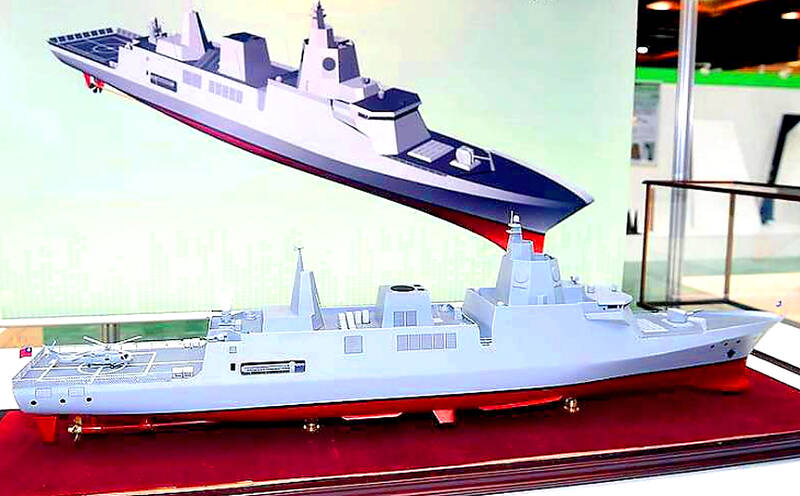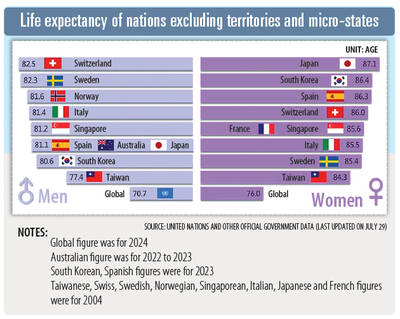Axe bows should be used for the navy’s next-generation 6,500-tonne destroyers, a study recommended.
An unclassified abstract uploaded to the Government Research Bulletin this month showed that National Cheng Kung University (NCKU) conducted the research from April last year through last month.
The Government Research Bulletin is a Web site that manages research conducted by Control Yuan-affiliated agencies.

Photo: Taipei Times
The study used ship models at the university’s towing tank to compare conventional, axe and wave-piercing bows in terms of their ability to lower resistance, and their seaworthiness and sonar dome noise reduction at varying speeds, the abstract said.
The data are to be combined with flow simulations in follow-up studies to inform the design of the destroyers, it said.
Conventional bows are slightly better than axe bows and significantly superior to wave-piercing hulls in cutting resistance, it said.
The three bow types are equally seaworthy at low speeds, but conventional, axe and wave-piercing bows ranked first, second and third respectively in high-speed seaworthiness, with wave-piercing bows the worst due to a tendency to cause the deck to take on water, it said.
Axe bows are significantly better than the other types in reducing noise around the sonar dome, the researchers added.
NCKU researchers found that axe bows are the best compromise of lowering resistance, seaworthiness and noise reduction for destroyers, it said.
A defense official speaking on condition of anonymity previously said that the planned destroyers were projected to have a displacement of 6,000 tonnes to 8,000 tonnes and would be equipped with a battle management system equivalent to the US-designed Aegis system.
That would mean Taiwan’s next generation of principal surface combatants, if they are built, would be about the size of Norway’s Fridtjof Nansen-class or Spain’s Alvaro de Bazan-class frigates, the official said.
On Jan. 16, Jong Shyn Shipbuilding Co conducted a ceremony presided over by Commander of the Navy Admiral Tang Hua (唐華) to mark the beginning of work on a 2,500-tonne light anti-submarine frigate at the firm’s Kaohsiung shipyards.
The light frigates were conceived as an alternative to the 4,500-tonne guided missile frigates, development of which has stalled amid a clash of vision between the Navy Command Headquarters and the Chung Shan Institute of Science and Technology.
Production of a sister ship configured for air defense was initiated in November last year.
Both types would be equipped with Hai Chien II air defense missiles, Hsiung Feng III anti-ship missiles and Artisan phased array 3D radar systems developed by BAE systems, the source said.
The anti-submarine warfare variant would have in addition to the other features an advanced active and passive towed sonar system manufactured by a classified source, they said.
Additional reporting by CNA

Eight restaurants in Taiwan yesterday secured a one-star rating from the Michelin Guide Taiwan for the first time, while three one-star restaurants from last year’s edition were promoted to two stars. Forty-three restaurants were awarded one star this year, including 34 in Taipei, five in Taichung and four in Kaohsiung. Hosu (好嶼), Chuan Ya (川雅), Sushi Kajin (鮨嘉仁), aMaze (心宴), La Vie by Thomas Buhner, Yuan Yi (元一) and Frassi in Taipei and Front House (方蒔) in Kaohsiung received a one-star rating for the first time. Hosu is known for innovative Taiwanese dishes, while Chuan Ya serves Sichuan cuisine and aMaze specializes

STATS: Taiwan’s average life expectancy of 80.77 years was lower than that of Japan, Singapore and South Korea, but higher than in China, Malaysia and Indonesia Taiwan’s average life expectancy last year increased to 80.77 years, but was still not back to its pre-COVID-19 pandemic peak of 81.32 years in 2020, the Ministry of the Interior said yesterday. The average life expectancy last year increased the 0.54 years from 2023, the ministry said in a statement. For men and women, the average life expectancy last year was 77.42 years and 84.30 years respectively, up 0.48 years and 0.56 years from the previous year. Taiwan’s average life expectancy peaked at 81.32 years in 2020, as the nation was relatively unaffected by the pandemic that year. The metric

Taitung County is to launch charter flights to Malaysia at the end of this year, after setting up flights to Vietnam and Thailand, the Taitung County Government said yesterday. The new charter flight services, provided by low-cost carrier Batik Air Malaysia, would be part of five-day tour packages for visits to Taitung County or Malaysia. The Batik Air charter flight, with about 200 seats, would take Malaysian tourists to Taitung on Dec. 30 and then at 12:35pm return to Kuala Lumpur with Taiwanese tourists. Another charter flight would bring the Taiwanese home on Jan. 3 next year, arriving at 5:30pm, before taking the

Taiwan High Speed Rail Corp. (THSRC) plans to ease strained capacity during peak hours by introducing new fare rules restricting passengers traveling without reserved seats in 2026, company Chairman Shih Che (史哲) said Wednesday. THSRC needs to tackle its capacity issue because there have been several occasions where passengers holding tickets with reserved seats did not make it onto their train in stations packed with individuals traveling without a reserved seat, Shih told reporters in a joint interview in Taipei. Non-reserved seats allow travelers maximum flexibility, but it has led to issues relating to quality of service and safety concerns, especially during